Debate_teaching(辩论流程)
英语辩论赛的详细流程
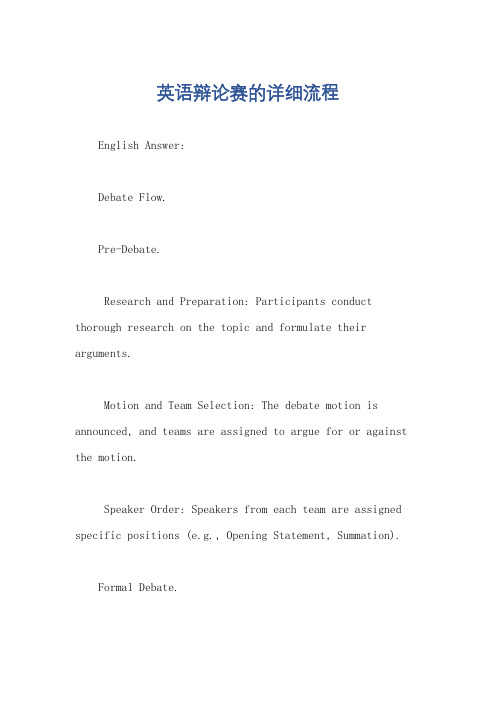
英语辩论赛的详细流程English Answer:Debate Flow.Pre-Debate.Research and Preparation: Participants conduct thorough research on the topic and formulate their arguments.Motion and Team Selection: The debate motion is announced, and teams are assigned to argue for or against the motion.Speaker Order: Speakers from each team are assigned specific positions (e.g., Opening Statement, Summation).Formal Debate.Round 1: Opening Statements.Affirmative Case (For the Motion): The first affirmative speaker presents the main argument in favor of the motion.Negative Case (Against the Motion): The first negative speaker presents the main argument against the motion.Round 2: Cross-Examination.Affirmative Cross-Examination: The first negative speaker questions the first affirmative speaker on their points and evidence.Negative Cross-Examination: The first affirmative speaker questions the first negative speaker on their points and evidence.Round 3: Speeches.Second Affirmative Speech: The second affirmativespeaker provides additional support and evidence for the motion.Second Negative Speech: The second negative speaker provides additional support and evidence against the motion.Round 4: Rebuttal.Affirmative Rebuttal: The first affirmative speaker addresses the points raised by the negative team during cross-examination.Negative Rebuttal: The first negative speaker addresses the points raised by the affirmative team during cross-examination.Round 5: Third Speeches.Third Affirmative Speech: The third affirmativespeaker summarizes the case for the motion and responds to any remaining arguments from the negative team.Third Negative Speech: The third negative speaker summarizes the case against the motion and responds to any remaining arguments from the affirmative team.Round 6: Summation.Affirmative Summation: The affirmative team presents a final overview of their arguments and appeals to the adjudicator.Negative Summation: The negative team presents a final overview of their arguments and appeals to the adjudicator.Adjudication.Judge Deliberation: The adjudicator considers the arguments presented by both teams and evaluates their effectiveness.Verdict: The adjudicator announces the winning team and provides a brief justification for their decision.中文回答:辩论流程。
英语辩论赛流程及规则

英语辩论赛流程及规则English Answer:Debate Format and Rules.Pre-Debate Preparations:Topic selection: The topic for the debate is mutually agreed upon by the participating teams.Team composition: Each team consists of two or three speakers, one of whom serves as the captain.Research and preparation: Teams conduct thorough research and prepare arguments in support of their respective positions.Debate Structure:1. Opening Statements (4 minutes per team): Each teampresents an overview of their case, stating their main arguments and evidence.2. Cross-examination (4 minutes per team): Teams have the opportunity to question the opposing team's speakers.3. Rebuttal (3 minutes per team): Teams respond to the arguments and evidence presented by the opposing team.4. Closing Statements (3 minutes per team): Teams summarize their main points, reiterate their arguments, and conclude their case.Debate Rules:1. Time limits: Each team has a specified time limitfor each portion of the debate.2. Order of speakers: The order of speakers is determined by the debate format and team agreement.3. Respectful conduct: Speakers must treat each otherand the audience with respect, refraining from personal attacks or interruptions.4. Citing sources: Speakers must cite any sources used to support their arguments.5. No new evidence: Teams cannot introduce new evidence during cross-examination or rebuttal.Judging Criteria:Judges evaluate teams based on the following criteria:Content: The strength, clarity, and relevance of the arguments presented.Delivery: The effectiveness of the speaker's communication skills, including clarity of speech, organization, and engagement with the audience.Rebuttal: The ability to respond effectively to the opposing team's arguments.Overall impression: The team's overall impact on the audience and the judges.中文回答:辩论赛流程及规则。
准备辩论赛辩题的简单流程

准备辩论赛辩题的简单流程英文回答:As a seasoned debater, I have honed my skills in crafting persuasive arguments and anticipating my opponents' strategies. When preparing for a debate, Ifollow a meticulous process that ensures I am well-equipped to tackle any topic.1. Define the Topic and Terms: The first step is to clearly understand the debate topic and any key terms. I break down the topic into its main components, identifying the premise, assumptions, and any potential areas of contention.2. Research Extensively: Once the topic is clear, I embark on thorough research to gather evidence, data, and expert opinions that support my position. I consult books, articles, academic journals, and online resources to build a solid knowledge base.3. Craft an Argument: With my research complete, I develop my argument in a logical and structured manner. I identify the main points of my argument and support themwith evidence. I also anticipate potential objections and prepare counterarguments to refute them.4. Practice and Refine: After shaping my argument, I engage in extensive practice to sharpen my delivery and refine my reasoning. I test my arguments against opposing viewpoints, seeking feedback from coaches and fellow debaters to identify areas for improvement.5. Anticipate Counterarguments: I dedicate time to anticipating counterarguments that my opponents might raise.I consider potential flaws in my argument and develop strategies to address these challenges effectively.6. Stay Informed and Flexible: The world is constantly evolving, so I make it a priority to stay informed about current events and emerging perspectives. This allows me to tailor my arguments to the latest developments and respondto unforeseen challenges.中文回答:作为一名经验丰富的辩论者,我在构建有说服力的论点和预测对手策略方面磨练了自己的技巧。
辩论赛环节流程英语

辩论赛环节流程英语Debate Competition ProcessGood morning/afternoon everyone. Today we will be discussing the process of a debate competition.1. Opening Statements:The first step in a debate competition is the opening statements. Each team presents their position on the given topic and outlines their main arguments.开场陈述:辩论赛的第一步是开场陈述。
每个团队都会对所给话题提出自己的立场,并概述他们的主要论点。
2. Cross-Examination:After the opening statements, there is a cross-examination period where teams have the opportunity to question each other on their arguments and evidence.质询环节:在开场陈述之后,会有一个质询期,团队有机会就彼此的论点和证据进行质询。
3. Rebuttal:Following the cross-examination, each team presentstheir rebuttal where they counter the arguments made by the opposing team and strengthen their own position.反驳:在质询之后,每个团队都会进行反驳,他们会反驳对方团队提出的论点,并加强自己的立场。
4. Closing Statements:The debate competition concludes with closing statements where each team summarizes their main points and makes a final appeal to the judges.结束陈述:辩论赛以结束陈述结束,每个团队总结他们的主要论点,并向评委做最后的呼吁。
辩论赛程序及方法

辩论赛程序及方法辩论赛是一种常见的学术竞赛形式,旨在通过对立观点的辩论,展示参赛者的逻辑思维、口头表达以及团队协作能力。
本文将介绍辩论赛的基本程序与方法,以帮助参赛者更好地准备和参与辩论赛。
一、辩论赛的基本程序1. 预备期 (Preparation Time):辩论赛开始前,参赛队伍将有一段预备时间,通常为几分钟至二十分钟不等。
在此期间,队员可以策划并讨论辩论的立场、论据、反驳等。
2. 正式辩论 (Formal Debate):辩论赛正式开始后,一般分为开场陈述、驳斥对方观点和总结陈词三个阶段。
a) 开场陈述 (Opening Statements):开场陈述是辩论的第一步,每个队伍的一名代表将以确定的时间限制内介绍自己的立场和主要论点。
开场陈述应包含简明扼要的论点陈述,概括性的证据和注意引起对方注意的开场语。
b) 驳斥对方观点 (Rebuttals):接下来的阶段是辩论队伍之间的互相驳斥。
每个队伍的成员将针对对方的陈述提出质疑、进一步解释自己的观点,并驳斥对方的论据。
该阶段要求参赛者保持冷静、聚焦主题,并提供有力的论据支持自己的立场。
c) 总结陈词 (Closing Statements):辩论的最后一个阶段是总结陈词。
每个队伍的一名代表将总结自己的立场,并强调自己的主要论点和对方观点的不足。
总结陈词通常要求参赛者具备较好的归纳总结能力和强有力的表达能力。
3. 问题与回答 (Questions and Answers):辩论赛正式结束后,通常会有一个问题与回答环节。
此时评委或观众可以向参赛者提问,参赛者需要清晰明确地回答问题,并展示自己的专业知识和反应能力。
二、辩论赛的方法与技巧1. 准备充分:参赛队伍在辩论前要做充分的准备。
了解辩论题目,收集相关材料和数据,针对不同的立场进行论证和反驳,以确保能够有力地表达和捍卫自己的观点。
2. 开放式和封闭式辩论:开放式辩论中,参赛者可以自主选择立场,并自由辩论。
英语辩论赛流程稿

英语辩论赛流程稿English: In a traditional English debate competition, the process typically begins with a coin toss to determine which team will speak first.Chinese: 在传统的英语辩论比赛中,辩论的流程通常是先进行一次抛硬币,来确定哪个队伍先发言。
English: After the coin toss, the first team will present their argument or position on the given topic. They will have a specified amount of time to share their initial points and evidence.Chinese: 在硬币抛掷后,第一个队伍会陈述他们对于给定话题的论点或立场。
他们会有特定的时间来分享他们的初步观点和证据。
English: Following the first team's presentation, the opposing team will then have the opportunity to counter the arguments presentedby the first team. This allows for a back-and-forth exchange of ideas and evidence.Chinese: 在第一个队伍的陈述之后,反对方的队伍将有机会反驳第一个队伍提出的论点。
这样可以进行一场观点和证据的来回交流。
English: After both teams have presented their initial arguments and counter-arguments, there will often be a period of cross-examination. During this time, members of each team will have the opportunity to question the opposing team's points and evidence.Chinese: 在两个队伍都陈述了他们的论点和反驳后,通常会有一个交叉审问的时间。
外研社英语辩论赛流程及规则

外研社英语辩论赛流程及规则The English Debate Competition Hosted by the Foreign Language Teaching and Research Press: Procedures and RulesThe Foreign Language Teaching and Research Press (FLTRP) is a renowned educational publishing house in China that has been actively promoting the development of English language education in the country. One of their flagship initiatives is the annual English Debate Competition, which has become a highly anticipated event for students and schools across the nation. This competition provides a platform for students to showcase their English language proficiency, critical thinking skills, and public speaking abilities. In this essay, we will delve into the procedures and rules governing this prestigious competition.The FLTRP English Debate Competition is open to secondary school students from all over China. The competition is structured in a way that allows participants to engage in lively and thought-provoking discussions on a variety of topics. The competition typically consists of several rounds, each with its own set of guidelines and requirements.The first round of the competition is the preliminary round, where teams of two to three students compete against each other. In this round, teams are given a motion, which is a statement or proposition that they must either support or oppose. Teams are given a limited amount of time, usually around 30 minutes, to prepare their arguments and strategies. During the debate, each team member takes on a specific role, such as the opening speaker, the rebuttal speaker, or the closing speaker.The preliminary round is designed to assess the teams' ability to research, analyze, and articulate their arguments effectively. The judges, who are typically experienced educators or debate coaches, evaluate the teams based on criteria such as the strength of their arguments, the clarity of their communication, and their ability to respond to the opposing team's points.The teams that emerge victorious from the preliminary round move on to the semi-final round. In this round, the level of competition intensifies, as the teams are now required to engage in a more complex and nuanced debate. The motions in the semi-final round are often more challenging and thought-provoking, requiring the teams to delve deeper into the issues and consider multiple perspectives.During the semi-final round, the teams are given more time toprepare, usually around 45 minutes. This allows them to conduct more extensive research, develop more sophisticated arguments, and anticipate potential counterarguments from their opponents. The judges in this round are typically more experienced and knowledgeable, and they evaluate the teams based on a more comprehensive set of criteria.The teams that excel in the semi-final round then advance to the grand final, which is the culmination of the FLTRP English Debate Competition. This final round is a highly anticipated event, with the winning teams receiving prestigious awards and recognition. The grand final is typically held in a larger venue, with a larger audience in attendance, including parents, teachers, and distinguished guests.In the grand final, the teams are given even more time to prepare, usually around 60 minutes. The motion for the final round is often the most challenging and thought-provoking of the entire competition. The teams are expected to demonstrate their mastery of the English language, their ability to think critically and strategically, and their capacity to engage in a lively and engaging debate.The judges in the grand final are the most experienced and respected individuals in the field of English language education and debate. They evaluate the teams based on a comprehensive set ofcriteria, including the quality of their arguments, the clarity and coherence of their communication, their ability to respond to the opposing team's points, and their overall performance and stage presence.The FLTRP English Debate Competition is not just a showcase of academic excellence; it is also an opportunity for students to develop valuable life skills. Through the process of preparing for and participating in the competition, students learn how to research and analyze complex issues, how to structure and present their arguments effectively, and how to think critically and respond to opposing viewpoints.Moreover, the competition fosters a sense of camaraderie and teamwork among the participants, as they work together to develop their strategies and support one another throughout the various rounds. This experience can be particularly valuable for students as they navigate the challenges of their academic and personal lives.In conclusion, the FLTRP English Debate Competition is a highly prestigious and well-organized event that provides a platform for secondary school students to showcase their English language proficiency and critical thinking skills. The competition's rigorous procedures and well-defined rules ensure that the participants are evaluated fairly and that the winners are truly deserving of theaccolades they receive. By participating in this competition, students not only have the opportunity to demonstrate their academic prowess but also to develop valuable life skills that will serve them well in their future endeavors.。
英文辩论赛流程与规则
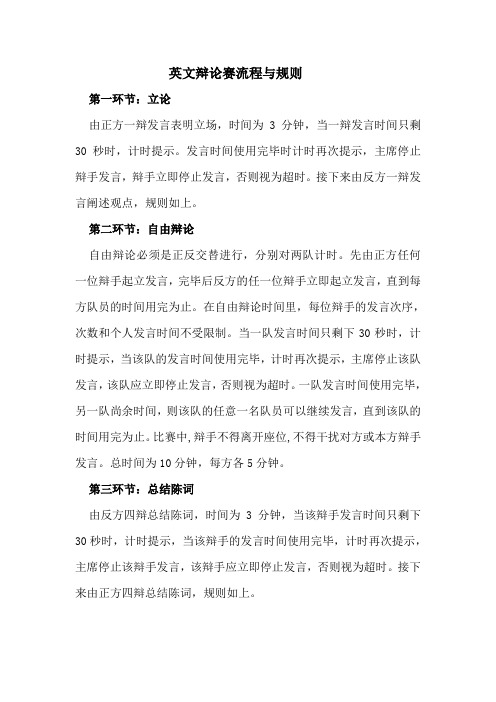
英文辩论赛流程与规则
第一环节:立论
由正方一辩发言表明立场,时间为3分钟,当一辩发言时间只剩30秒时,计时提示。
发言时间使用完毕时计时再次提示,主席停止辩手发言,辩手立即停止发言,否则视为超时。
接下来由反方一辩发言阐述观点,规则如上。
第二环节:自由辩论
自由辩论必须是正反交替进行,分别对两队计时。
先由正方任何一位辩手起立发言,完毕后反方的任一位辩手立即起立发言,直到每方队员的时间用完为止。
在自由辩论时间里,每位辩手的发言次序,次数和个人发言时间不受限制。
当一队发言时间只剩下30秒时,计时提示,当该队的发言时间使用完毕,计时再次提示,主席停止该队发言,该队应立即停止发言,否则视为超时。
一队发言时间使用完毕,另一队尚余时间,则该队的任意一名队员可以继续发言,直到该队的时间用完为止。
比赛中,辩手不得离开座位,不得干扰对方或本方辩手发言。
总时间为10分钟,每方各5分钟。
第三环节:总结陈词
由反方四辩总结陈词,时间为3分钟,当该辩手发言时间只剩下30秒时,计时提示,当该辩手的发言时间使用完毕,计时再次提示,主席停止该辩手发言,该辩手应立即停止发言,否则视为超时。
接下来由正方四辩总结陈词,规则如上。
debate课程教学大纲

debate课程教学大纲Debate课程教学大纲引言:在当今社会,培养学生的辩论能力已经成为教育的重要目标之一。
辩论能够帮助学生发展批判性思维、逻辑思维、口头表达和团队合作等重要技能。
因此,设计一份全面而有深度的Debate课程教学大纲是至关重要的。
本文将探讨Debate课程教学大纲的内容和结构。
一、课程目标Debate课程的目标是培养学生的辩论技能,包括:1. 发展批判性思维:培养学生评估和分析观点的能力,学会提出有力的论证和反驳。
2. 培养逻辑思维:让学生学会构建逻辑连贯的论证链条,提高逻辑思维的准确性和有效性。
3. 提高口头表达能力:培养学生清晰、有说服力和自信的口头表达能力。
4. 培养团队合作能力:让学生学会与他人合作,共同准备和展示辩论。
二、课程内容1. 辩论基础知识:a. 辩论定义和历史:介绍辩论的定义和起源,让学生了解辩论的重要性和应用领域。
b. 辩论术语和规则:教授辩论中常用的术语和规则,如立论、论据、反驳等,以及辩论比赛的规则和格式。
c. 辩论案例分析:分析经典的辩论案例,让学生学会从中提取论点和论据,并对辩论策略进行评估。
2. 辩论技巧:a. 论证技巧:教授学生如何构建有效的论证链条,包括使用事实、统计数据、权威引用等支持论点。
b. 反驳技巧:培养学生学会有效地反驳对方观点,包括提出合理的质疑、揭示逻辑漏洞等。
c. 强化口头表达能力:训练学生在有限时间内清晰、有条理地表达自己的观点,并回应对方的反驳。
3. 辩论实践:a. 小组讨论:组织学生进行小组讨论,让他们学会合作和协商,共同准备辩论。
b. 模拟辩论:组织学生进行模拟辩论,让他们在真实的辩论场景中应用所学技巧和知识。
c. 辩论比赛:组织学生参加辩论比赛,提供一个实践和展示辩论技能的机会。
三、评估方式为了评估学生的辩论能力和理解程度,可以采用以下评估方式:1. 辩论表现评估:评估学生在辩论中的表现,包括论证的逻辑性、反驳的有效性和口头表达的清晰度等。
Debate teaching(辩论流程)

Supporting Your Opinion
Support consists of evidence: four kinds of evidence 1. Example: Common Sense: things that you from your own experience or from what you heard or read. 2. believe everybody knows. 3. Expert Opinion: the opinions of experts -- this comes from research. 4. Statistics: numbers -- this also comes from research.
• secondhand smoke is harmful for nonsmokers.
strong
Exercise
Think of at Least One Strong Reason for Each Resolution 1. Women should quit their job after they get married. REASON:
Opinions and Reasons
The students either agree or disagree with the resolution regardless of what they personally believe. An opinion can be introduced by an opinion indicator:
Basic Terms
Debate: a game in which two opposing teams make speeches to support their arguments and disagree with those of the other team.
关于英语辩论赛流程_辩论赛_
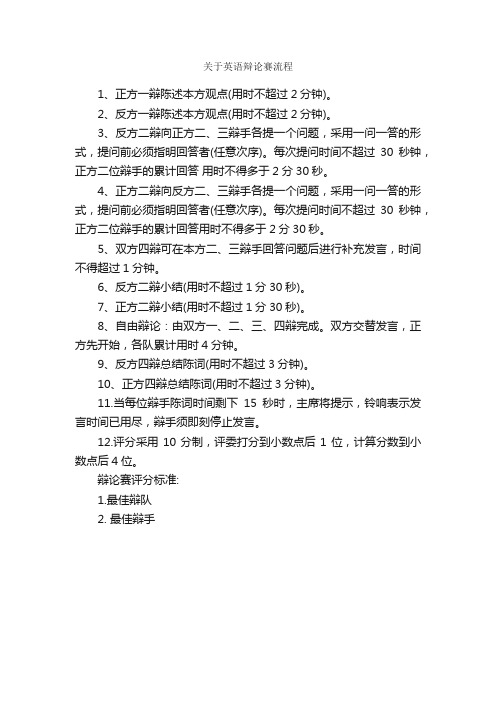
关于英语辩论赛流程
1、正方一辩陈述本方观点(用时不超过2分钟)。
2、反方一辩陈述本方观点(用时不超过2分钟)。
3、反方二辩向正方二、三辩手各提一个问题,采用一问一答的形式,提问前必须指明回答者(任意次序)。
每次提问时间不超过30秒钟,正方二位辩手的累计回答用时不得多于2分30秒。
4、正方二辩向反方二、三辩手各提一个问题,采用一问一答的形式,提问前必须指明回答者(任意次序)。
每次提问时间不超过30秒钟,正方二位辩手的累计回答用时不得多于2分30秒。
5、双方四辩可在本方二、三辩手回答问题后进行补充发言,时间不得超过1分钟。
6、反方二辩小结(用时不超过1分30秒)。
7、正方二辩小结(用时不超过1分30秒)。
8、自由辩论:由双方一、二、三、四辩完成。
双方交替发言,正方先开始,各队累计用时4分钟。
9、反方四辩总结陈词(用时不超过3分钟)。
10、正方四辩总结陈词(用时不超过3分钟)。
11.当每位辩手陈词时间剩下15秒时,主席将提示,铃响表示发言时间已用尽,辩手须即刻停止发言。
12.评分采用10分制,评委打分到小数点后1位,计算分数到小数点后4位。
辩论赛评分标准:
1.最佳辩队
2. 最佳辩手。
英语辩论赛流程规则(3篇)
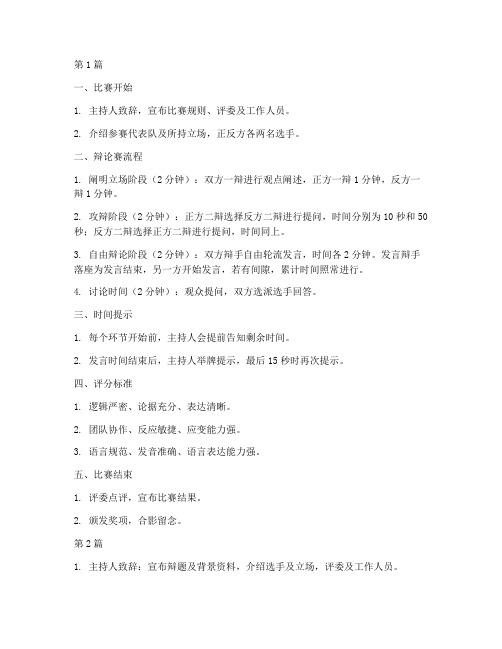
第1篇一、比赛开始1. 主持人致辞,宣布比赛规则、评委及工作人员。
2. 介绍参赛代表队及所持立场,正反方各两名选手。
二、辩论赛流程1. 阐明立场阶段(2分钟):双方一辩进行观点阐述,正方一辩1分钟,反方一辩1分钟。
2. 攻辩阶段(2分钟):正方二辩选择反方二辩进行提问,时间分别为10秒和50秒;反方二辩选择正方二辩进行提问,时间同上。
3. 自由辩论阶段(2分钟):双方辩手自由轮流发言,时间各2分钟。
发言辩手落座为发言结束,另一方开始发言,若有间隙,累计时间照常进行。
4. 讨论时间(2分钟):观众提问,双方选派选手回答。
三、时间提示1. 每个环节开始前,主持人会提前告知剩余时间。
2. 发言时间结束后,主持人举牌提示,最后15秒时再次提示。
四、评分标准1. 逻辑严密、论据充分、表达清晰。
2. 团队协作、反应敏捷、应变能力强。
3. 语言规范、发音准确、语言表达能力强。
五、比赛结束1. 评委点评,宣布比赛结果。
2. 颁发奖项,合影留念。
第2篇1. 主持人致辞:宣布辩题及背景资料,介绍选手及立场,评委及工作人员。
2. 比赛阶段:a. 阐明立场阶段:双方一辩分别进行1分钟观点阐述。
b. 攻辩阶段:双方二辩进行1分钟提问和回答。
c. 自由辩论阶段:双方各2分钟,辩手可自由轮流发言。
d. 讨论时间:观众提问,双方选派选手作答。
3. 规则:a. 发言时间:正方一辩1分钟,反方一辩1分钟,正方二辩1分钟,反方二辩1分钟,总结发言正方5分钟,反方4分钟。
b. 提问和回答时间:10秒提问,50秒回答。
c. 举牌提示:每分钟结束时举牌提示,最后15秒举牌提示。
d. 时间宽限期:20秒。
e. 超时扣分:超时或时间不足,评委会扣分。
4. 评分标准:a. 论点清晰、逻辑严密。
b. 语言表达流畅、准确。
c. 辩论技巧:提问、回答、反驳等。
d. 团队协作与配合。
5. 评委打分:评委根据以上标准进行打分,最终结果以平均分为准。
第3篇一、主持人致辞:1. 宣布辩题及辩题相关背景资料;2. 介绍选手及正反方所持观点;3. 介绍评委及工作人员。
英语辩论赛流程及规则

英语辩论赛流程及规则Title: The Process and Rules of an English Debate CompetitionAn English debate competition is a formal discussion where two teams, typically consisting of three members each, present arguments for and against a given proposition or resolution. These competitions provide a platform for participants to showcase their critical thinking, public speaking, and persuasive skills. The process and rules of an English debate competition are crucial to ensure a fair and structured event.1. Preparation Stage:a. Topic Selection: The organizers of the debate competition will provide the topic or resolution to be debated. This topic is typically a controversial or thought-provoking issue that allows for the presentation of different perspectives.b. Team Composition: Each team consists of three members, typically referred to as the first speaker, second speaker, and third speaker. These members work collaboratively to research the topic, develop arguments, and refine their presentation.c. Research and Argument Development: Teams extensively research the topic, gather relevant information, and formulate strong arguments to support their position. They also anticipate counterarguments from the opposing team and prepare rebuttals.d. Constructing the Debate Case: The teams organize their arguments, evidence, and rebuttals into a coherent and persuasive case. They strategize the order and timing oftheir speeches to maximize the impact of their arguments.2. The Debate Format:a. Opening Statements:i. Affirmative Team (First Speaker): The first speaker of the affirmative team presents the team's position and the key arguments supporting the resolution.ii. Negative Team (First Speaker): The first speaker of the negative team outlines the team's position and the main arguments against the resolution.b. Rebuttal Speeches:i. Affirmative Team (Second Speaker): The second speaker of the affirmative team responds to the arguments presented by the negative team and reinforces the affirmative case.ii. Negative Team (Second Speaker): The second speaker of the negative team challenges the arguments made by the affirmative team and presents the negative team's counterarguments.c. Cross-Examination:i. Affirmative Team (Third Speaker): The third speaker of the affirmative team questions the negative team, aiming to expose weaknesses in their arguments or uncover inconsistencies.ii. Negative Team (Third Speaker): The third speaker of the negative team questions the affirmative team, attempting to undermine their arguments or highlight flaws in their reasoning.d. Closing Statements:i. Negative Team (Third Speaker): The third speaker of the negative team summarizes the team's key arguments and provides a final rebuttal to the affirmative team's case.ii. Affirmative Team (Third Speaker): The third speaker of the affirmative team delivers a concluding statement, reinforcing the team's position and highlighting the strengths of their arguments.3. Judging and Scoring:a. Judging Criteria: The debate is typically judged by a panel of experienced adjudicators or judges who evaluate the teams based on specific criteria, such as:i. Argumentation: The strength, logic, and coherence of the arguments presented.ii. Refutation: The ability to identify and effectively respond to the opposing team's arguments.iii. Delivery: The clarity, fluency, and persuasiveness of the speakers' presentation.iv. Teamwork: The coordination and collaboration within the team.b. Scoring System: The judges assign points to each team based on their performance, with the team that accumulates the highest score being declared the winner.4. Principles of Ethical Debating:a. Respect for the Opposition: Debaters should maintain a respectful and professional attitude towards the opposing team, avoiding personal attacks or derogatory language.b. Truthfulness and Integrity: Participants are expectedto present factual information and arguments, refraining from the use of false or misleading statements.c. Fairness and Objectivity: Judges should strive to evaluate the teams impartially, basing their decisions solely on the merits of the arguments presented.d. Sportsmanship: Participants should demonstrate good sportsmanship, accepting the outcome of the debate gracefully, regardless of the result.5. Benefits of Participating in English Debate Competitions:a. Improved Communication Skills: Debating fosters the development of effective public speaking, active listening, and persuasive communication skills.b. Critical Thinking and Problem-Solving: The process of researching, analyzing, and formulating arguments encourages critical thinking and the ability to approach complex issues from multiple perspectives.c. Intellectual Stimulation: Engaging in debates exposes participants to diverse viewpoints and challenges them to think deeply about controversial topics.d. Confidence and Leadership: Successful participation in debates can boost individuals' confidence and leadership skills, as they learn to articulate their ideas effectively and think on their feet.e. Networking and Collaboration: Debating competitions provide opportunities for participants to connect with like-minded individuals, fostering networking and collaboration.In conclusion, the process and rules of an English debate competition are designed to create a fair, structured, and intellectually stimulating environment for participants to showcase their skills and engage in meaningful discussions. By following these guidelines, debaters can develop essential communication, critical thinking, and problem-solving abilities, which can be valuable assets in various personal and professional settings.。
英文辩论赛流程
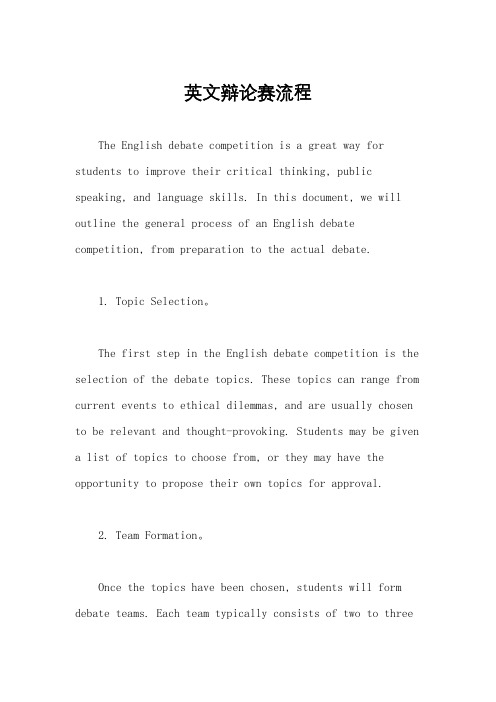
英文辩论赛流程The English debate competition is a great way for students to improve their critical thinking, public speaking, and language skills. In this document, we will outline the general process of an English debate competition, from preparation to the actual debate.1. Topic Selection。
The first step in the English debate competition is the selection of the debate topics. These topics can range from current events to ethical dilemmas, and are usually chosen to be relevant and thought-provoking. Students may be given a list of topics to choose from, or they may have the opportunity to propose their own topics for approval.2. Team Formation。
Once the topics have been chosen, students will form debate teams. Each team typically consists of two to threemembers, with one member designated as the lead speaker. It is important for the team members to work together cohesively and to allocate specific roles and responsibilities for each member.3. Research and Preparation。
英语阅读教学设计中debate流程

Debate流程是指进行辩论的步骤。
在英语阅读教学中,教师可以采用以下流程进行Debate活动:
1.准备阶段:教师要准备好辩论的主题、辩论规则、辩论框架、辩论组别等。
2.讲解阶段:教师要讲解辩论的流程、规则、框架等内容,让学生清楚地了解辩论的
要求。
3.队伍建立阶段:教师要让学生根据自己的观点和立场,分为“正方”和“反方”两组,
并让学生根据规则选择辩手和防守者。
4.辩论阶段:教师要让学生按照规则进行辩论,并及时纠正学生的错误。
5.总结阶段:教师要帮助学生总结辩论的过程和结果,并对学生的表现进行评价。
准备辩论赛辩题的简单流程

准备辩论赛辩题的简单流程英文回答:Preparing for a debate competition involves several key steps to ensure that you are well-prepared to present your arguments and counterarguments effectively. The process can be broken down into the following simple steps.Firstly, it is important to thoroughly research the chosen debate topic. This involves gathering information from a variety of reputable sources, such as academic journals, books, and credible websites. It is essential to understand the different perspectives and arguments surrounding the topic in order to form a well-rounded view.Next, it is crucial to outline your own arguments and supporting evidence. This involves organizing your thoughts and evidence in a clear and logical manner, ensuring that your points are well-supported and coherent. It is also important to anticipate potential counterarguments andprepare responses to them.After outlining your own arguments, it is beneficial to practice delivering them in a persuasive and articulate manner. This may involve rehearsing in front of a mirror, recording yourself, or even participating in mock debates with peers. The goal is to become comfortable with presenting your arguments and responding to challenges from the opposing side.Furthermore, it is important to familiarize yourself with the rules and format of the debate competition. This includes understanding the time limits for speaking, the order of speakers, and any specific guidelines for the competition. By knowing the rules, you can ensure that you are well-prepared to participate in the debate.Finally, it is essential to remain open-minded and flexible throughout the preparation process. This involves being willing to adapt your arguments based on new information or perspectives that may arise. Additionally, it is important to stay calm and composed during the actualdebate, even in the face of challenging questions or opposition.中文回答:准备辩论比赛的过程包括多个关键步骤,以确保你能够充分准备,有效地提出自己的论点和反驳。
辩论赛流程规则自由辩论

辩论赛流程规则自由辩论Debating is a crucial skill that encourages critical thinking, effective communication, and the ability to articulate ideas convincingly. In a debate, participants engage in a structured discussion where they present arguments for or against a particular topic. The flow of a debate is regulated by specific rules that dictate how the debate is conducted, the speaking order of participants, and the criteria for judging the debate.辩论是一项至关重要的技能,它鼓励批判性思维,有效沟通,以及有说服力地表达观点的能力。
在辩论中,参与者参与一场结构化讨论,在讨论中他们针对特定主题提出论点。
辩论的流程是由特定规则规范的,这些规则规定了辩论的进行方式,参与者的发言顺序,以及评判辩论的标准。
The flow of a debate typically begins with the opening statements, where each team presents their arguments for or against the topic. This is followed by a period of rebuttals, where teams have the opportunity to challenge and respond to the arguments presented by the opposing team. The debate then moves into a cross-fireround, where participants engage in direct questioning and rebuttals with the opposing team.辩论的流程通常从开场陈述开始,每个团队都会为或反对该主题提出自己的论点。
辩论程序及时间安排

辩论程序及时间安排英文回答:Debating is an essential part of academic and professional development, as it allows individuals to critically analyze and defend their ideas. The debate process typically involves several key steps and a set time schedule to ensure that both sides have an equal opportunity to present their arguments.First and foremost, the debate begins with theselection of a topic. This topic should be relevant and thought-provoking, as it will serve as the foundation for the arguments presented by both sides. For example, in a debate about climate change, the topic could be "Resolved: The government should implement stricter regulations to combat climate change."Once the topic is selected, the next step is to establish a timeline for the debate. This timeline shouldinclude specific time limits for each stage of the debate, such as opening statements, rebuttals, and closing arguments. For instance, each team may be given 5 minutes for their opening statements, 3 minutes for rebuttals, and 2 minutes for closing arguments.After the timeline is set, the debate can begin. Each team takes turns presenting their arguments and responding to the opposing team's points. This back-and-forth exchange continues until both sides have had the opportunity to make their case.Finally, the debate concludes with a summary of the key points and a final statement from each team. This allowsfor a clear and concise recap of the arguments presented and gives each team a chance to leave a lasting impression on the audience.中文回答:辩论是学术和职业发展中不可或缺的一部分,因为它可以让个人批判性地分析和捍卫自己的观点。
- 1、下载文档前请自行甄别文档内容的完整性,平台不提供额外的编辑、内容补充、找答案等附加服务。
- 2、"仅部分预览"的文档,不可在线预览部分如存在完整性等问题,可反馈申请退款(可完整预览的文档不适用该条件!)。
- 3、如文档侵犯您的权益,请联系客服反馈,我们会尽快为您处理(人工客服工作时间:9:00-18:30)。
(2) The second round is refutation. (in this round, debaters should……) (3) The third round is free debating. (in this round, debaters should……) (4) The final round is position summary (conclusion ). (in this round, debaters should……) 5. Now it is time for questions from audiences (teacher). 6.let’s welcome our judges to give comments and declare the winner for today’s debate……
(2) This is the negative side. The first debater is *** from second …… third …… fourth …… ( fifth) (3) The judges today are…. (4)Welcome all of you.
3. Today’s topic is ******* (1) The opinion of the affirmative side is…… (2) The opinion of the negative side is …… (3) Provide some background information 4. Now, I declare that the debating begins. (1) The first round is position presentation (constructive speech) . (in this round debaters should…)
Debate
A debate is a contest, or, perhaps, like a game, where speakers present their arguments intent on persuading one another.
Debate purpose
Gloomy Sunday
Gloomy Sunday
"Gloomy Sunday" is a song composed by Hungarian pianist and composer Rezső Seress in 1933 to a Hungarian poem written by LászlóJávor .Owing to unsubstantiated urban legends about its inspiring hundreds of suicides, "Gloomy Sunday" was dubbed the "Hungarian suicide song" in the United States.
The classroom debates are exercises designed to allow you to strengthen your skills in the areas of leadership, interpersonal influence, teambuilding, group problem solving, and oral presentation.
• it is bad. weak • it gives people bad breath and makes their teeth yellow. • secondhand smoke is harmful for nonsmokers.
strong
Exercise
Think of at Least One Strong Reason for Each Resolution 1. Women should quit their job after they get married. REASON: 2. Love is more important than money. REASON: 3. It is better to be married than single. REASON: 4. Writing by hand is better than writing by computer. REASON: Compare Your Reasons with Another Pair and Decide Whose Reasons are Stronger and Why
Basic Terms
Debate: a game in which two opposing teams make speeches to support their arguments and disagree with those of the other team. Resolution: the opinion about which two teams argue. Affirmative team: agrees with the resolution. Negative team: disagrees with the resolution. Rebuttal: explains why one team disagrees with the other team. Judges/ Chairman/ Debaters/
Round 1 Position illustration
How to do?
Definition of key words
Each side has the right to make any reasonable definition of each of the terms of the resolution. A "reasonable" definition generally means the definition intended when the resolution was phrased, or the technical definition of the term as used by professionals in that field. If the affirmative's definition is not reasonable, the negative should challenge it at the earliest opportunity.
3. Chairman hosting
How to do?
chaJudges
1.welcome, everyone. I’m quite honored to chair this debating……. 2. First, let me introduce the two teams and judges for today’s debating. (1) This is the affirmative side. The first debater is *** second …… third …… fourth …… ( fifth)
Debate purpose
What’ s more? It can also help you writing an argumentation essay, which- a kind of debate in nature- may also appear in CET 4. E.g. Reading Selectively Or Extensively? (99年 CET4作文题) Is Television a Blessing or a Curse?
How to Debate?
Form Teams
Three students form a team. Affirmative team Negative team
Selecting Resolutions and Sides
Pick sides: affirmative or negative. One chairman judges audiences
Gloomy Sunday
《忧郁的星期天》(英语:Gloomy Sunday,匈牙利 语:Szomorú Vasárnap),也译作《黑色的星期天》 是匈牙利自学成才的作曲家赖热· 谢赖什(Rezső Seress,1899-1968年)谱写于1933年的一支歌曲。据 说,《忧郁的星期天》是赖热· 谢赖什和他的女友分手 后在极度悲恸的心情下创作出来。由于歌曲中流露出 慑人心魄的绝望神绪,数以百计的人在听了它后结束 了自己的生命。这支歌遂被冠以“匈牙利自杀歌”的 称号,甚至一度遭到了BBC等国际知名电台的禁播。 但是,并没有实质法律文献、期刊和出版物能证实该 自杀数字。
Philosophy of Debate
1. 2.
3.
Debate is subjective No “right” way . scores are going to be given according to your preparation and performance.
How to prepare?
We suggest that you follow these four steps: Read for background information about the subject. Prepare a comprehensive bibliography. Collect as much material as you can find. Read and study the material discovered.
